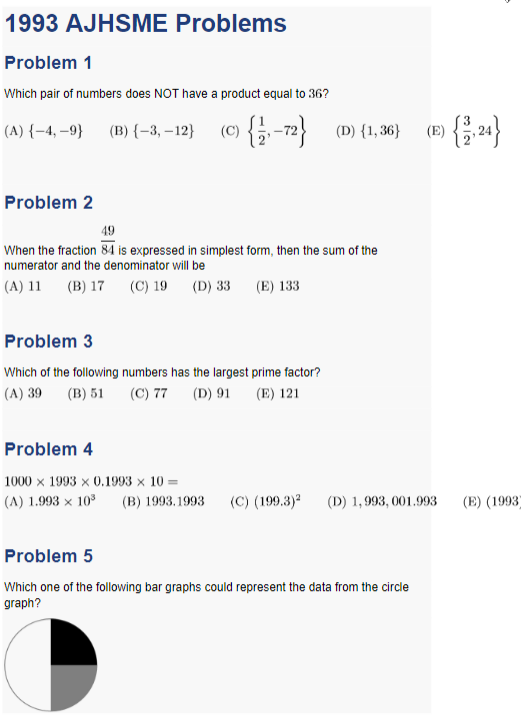2013年AIME I 真题:
Problem 1
The AIME Triathlon consists of a half-mile swim, a 30-mile bicycle ride, and an eight-mile run. Tom swims, bicycles, and runs at constant rates. He runs fives times as fast as he swims, and he bicycles twice as fast as he runs. Tom completes the AIME Triathlon in four and a quarter hours. How many minutes does he spend bicycling?
Problem 2
Find the number of five-digit positive integers, ![]() , that satisfy the following conditions:
, that satisfy the following conditions:
(a) the number n is divisible by 5,
- (b) the first and last digits of n are equal, and
- (c) the sum of the digits of n is divisible by 5.
Problem 3
Let ![]() be a square, and let
be a square, and let ![]() and
and ![]() be points on
be points on ![]() and
and ![]() respectively. The line through
respectively. The line through ![]() parallel to
parallel to ![]() and the line through
and the line through ![]() parallel to
parallel to ![]() divide
divide ![]() into two squares and two nonsquare rectangles. The sum of the areas of the two squares is
into two squares and two nonsquare rectangles. The sum of the areas of the two squares is ![]() of the area of square
of the area of square ![]() Find
Find ![]()
Problem 4
In the array of ![]() squares shown below,
squares shown below, ![]() squares are colored red, and the remaining
squares are colored red, and the remaining ![]() squares are colored blue. If one of all possible such colorings is chosen at random, the probability that the chosen colored array appears the same when rotated
squares are colored blue. If one of all possible such colorings is chosen at random, the probability that the chosen colored array appears the same when rotated ![]() around the central square is
around the central square is ![]() , where
, where ![]() is a positive integer. Find
is a positive integer. Find ![]() .
.
![[asy] draw((0,0)--(1,0)--(1,1)--(0,1)--(0,0)); draw((2,0)--(2,2)--(3,2)--(3,0)--(3,1)--(2,1)--(4,1)--(4,0)--(2,0)); draw((1,2)--(1,4)--(0,4)--(0,2)--(0,3)--(1,3)--(-1,3)--(-1,2)--(1,2)); draw((-1,1)--(-3,1)--(-3,0)--(-1,0)--(-2,0)--(-2,1)--(-2,-1)--(-1,-1)--(-1,1)); draw((0,-1)--(0,-3)--(1,-3)--(1,-1)--(1,-2)--(0,-2)--(2,-2)--(2,-1)--(0,-1)); size(100);[/asy]](https://latex.artofproblemsolving.com/1/1/a/11a69eb2f68ba08e0f212bacb515a331670c3d57.png)
Problem 5
The real root of the equation ![]() can be written in the form
can be written in the form ![]() , where
, where ![]() ,
, ![]() , and
, and ![]() are positive integers. Find
are positive integers. Find ![]() .
.
Problem 6
Melinda has three empty boxes and ![]() textbooks, three of which are mathematics textbooks. One box will hold any three of her textbooks, one will hold any four of her textbooks, and one will hold any five of her textbooks. If Melinda packs her textbooks into these boxes in random order, the probability that all three mathematics textbooks end up in the same box can be written as
textbooks, three of which are mathematics textbooks. One box will hold any three of her textbooks, one will hold any four of her textbooks, and one will hold any five of her textbooks. If Melinda packs her textbooks into these boxes in random order, the probability that all three mathematics textbooks end up in the same box can be written as ![]() , where
, where ![]() and
and ![]() are relatively prime positive integers. Find
are relatively prime positive integers. Find ![]() .
.
以下是我们为您整理的真题试卷,扫码即可免费领取完整版:
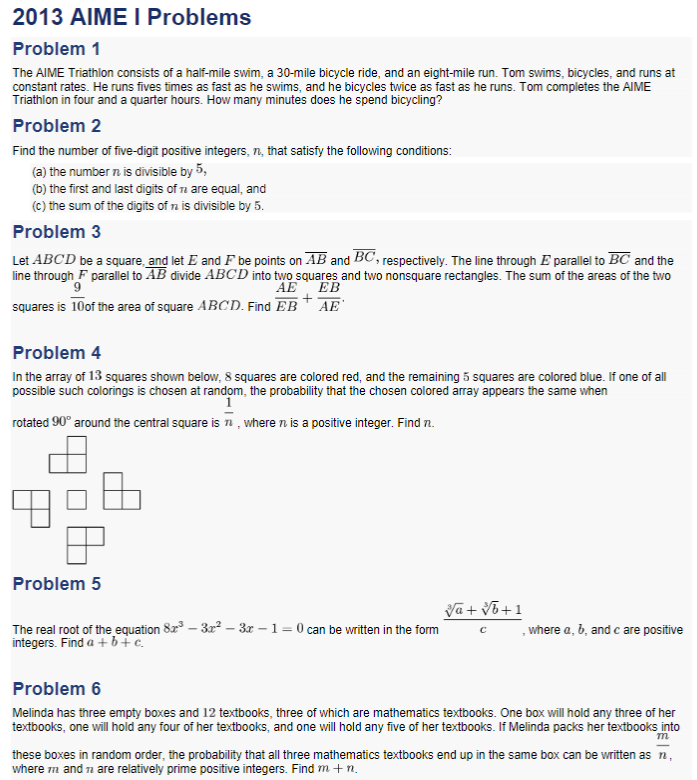

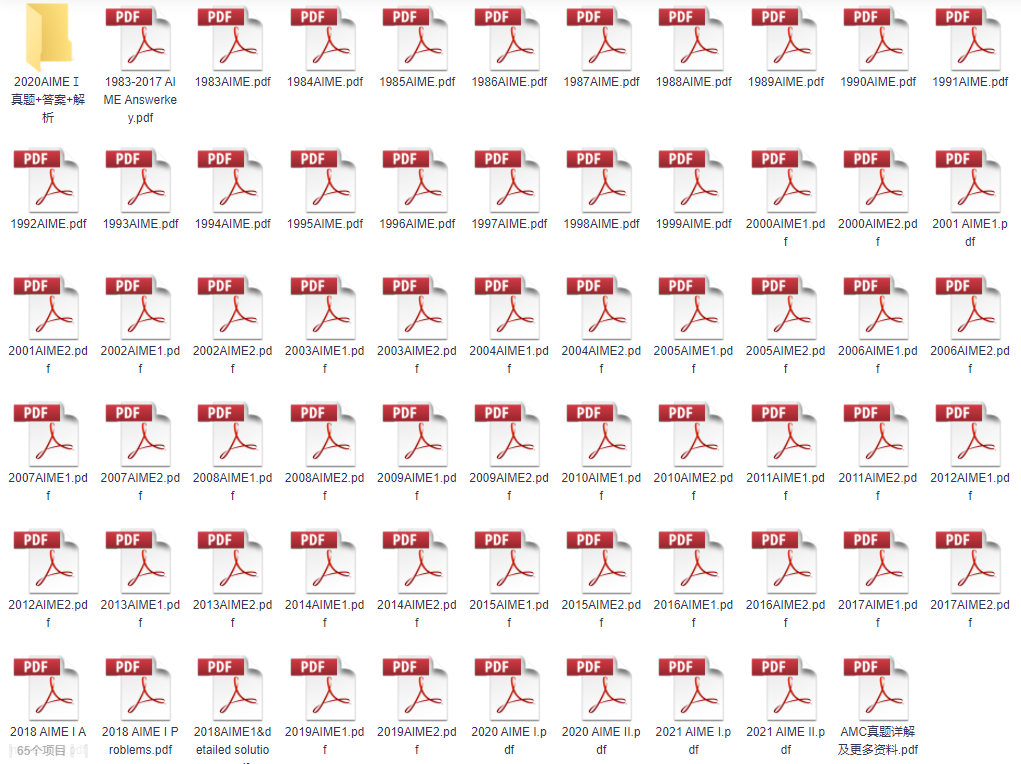
更多AIME 历年真题+真题详解
扫码添加顾问即可免费领取

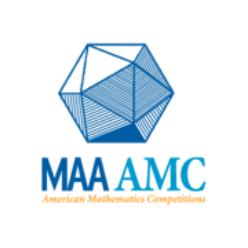
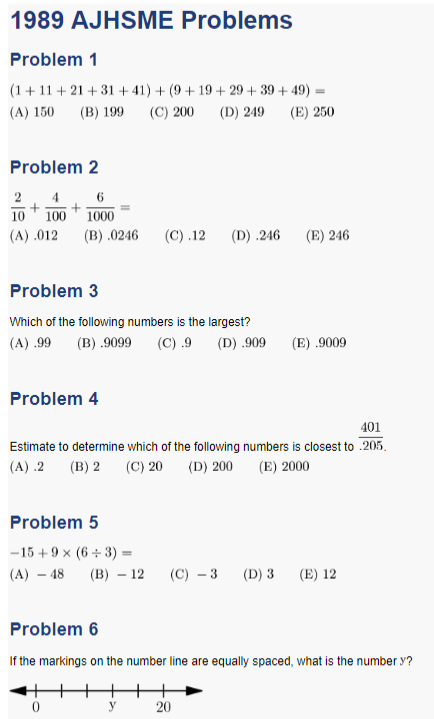

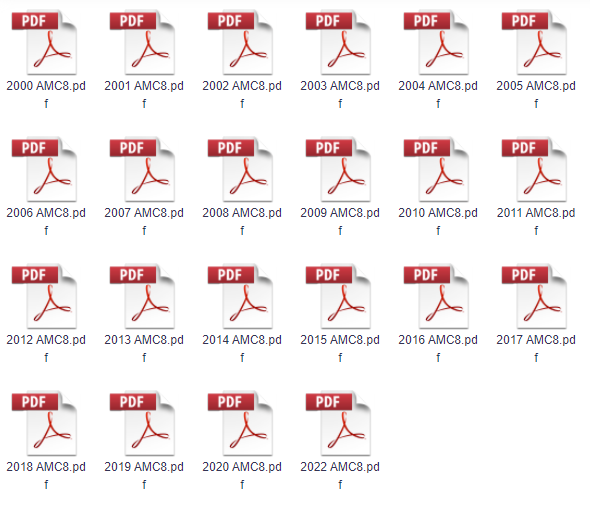
![[asy] draw((-3,0)..(0,3)..(3,0)); draw((-3.5,0)--(-2.5,0)); draw((0,2.5)--(0,3.5)); draw((2.5,0)--(3.5,0)); draw((1.8,1.8)--(2.5,2.5)); draw((-1.8,1.8)--(-2.5,2.5)); draw((0,0)--3*dir(120),EndArrow); label("$10$",(-2.6,0),E); label("$11$",(2.6,0),W); [/asy]](https://latex.artofproblemsolving.com/e/e/a/eea86891575ef6a6c7c90ff41c59a2a847689a3b.png)
![[asy] unitsize(12); //Force a white background in middle even when transparent fill((3,1)--(12,1)--(12,4)--(3,4)--cycle,white); //Black Squares, Gray Border (blends better than white) for(int a=0; a<7; ++a) { filldraw((2a,0)--(2a+1,0)--(2a+1,1)--(2a,1)--cycle,black,gray); } for(int b=7; b<15; ++b) { filldraw((b,14-b)--(b+1,14-b)--(b+1,15-b)--(b,15-b)--cycle,black,gray); } for(int c=1; c<7; ++c) { filldraw((c,c)--(c+1,c)--(c+1,c+1)--(c,c+1)--cycle,black,gray); } filldraw((6,4)--(7,4)--(7,5)--(6,5)--cycle,black,gray); filldraw((7,5)--(8,5)--(8,6)--(7,6)--cycle,black,gray); filldraw((8,4)--(9,4)--(9,5)--(8,5)--cycle,black,gray); //White Squares, Black Border filldraw((7,4)--(8,4)--(8,5)--(7,5)--cycle,white,black); for(int a=0; a<7; ++a) { filldraw((2a+1,0)--(2a+2,0)--(2a+2,1)--(2a+1,1)--cycle,white,black); } for(int b=9; b<15; ++b) { filldraw((b-1,14-b)--(b,14-b)--(b,15-b)--(b-1,15-b)--cycle,white,black); } for(int c=1; c<7; ++c) { filldraw((c+1,c)--(c+2,c)--(c+2,c+1)--(c+1,c+1)--cycle,white,black); } label("same",(6.3,2.45),N); label("pattern here",(7.5,1.4),N); [/asy]](https://latex.artofproblemsolving.com/c/4/1/c412ffe05ee5b02328949c1081a9349f0768892b.png)
![[asy] unitsize(36); pair A,B,C,D; A=3*dir(160); B=origin; C=3*dir(110); D=3*dir(20); draw((1.5,0)..(0,1.5)..(-1.5,0)); draw((2.5,0)..(0,2.5)..(-2.5,0)--cycle); draw(A--B); draw(C--B); draw(D--B); label("O",(-2.5,0),W); label("A",A,W); label("B",B,S); label("C",C,W); label("D",D,E); label("0",(-1.8,0),W); label("20",(-1.7,.5),NW); label("160",(1.6,.5),NE); label("180",(1.7,0),E); [/asy]](https://latex.artofproblemsolving.com/f/3/5/f35c58bf91cd15b3fe277437f0a010aeeef1f66d.png)
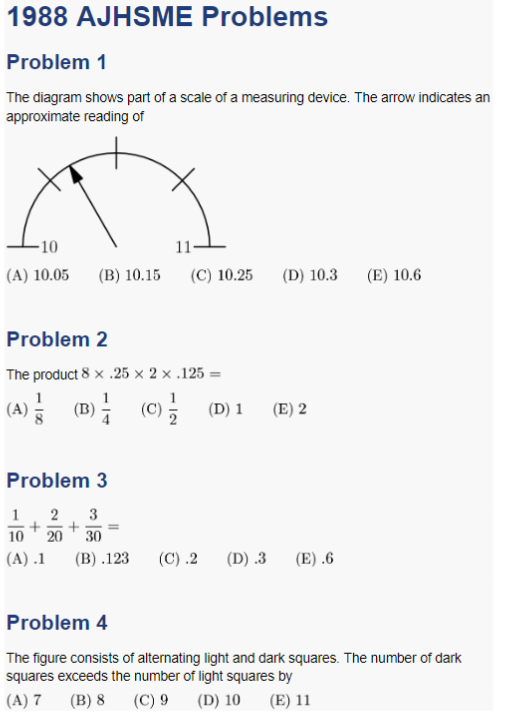
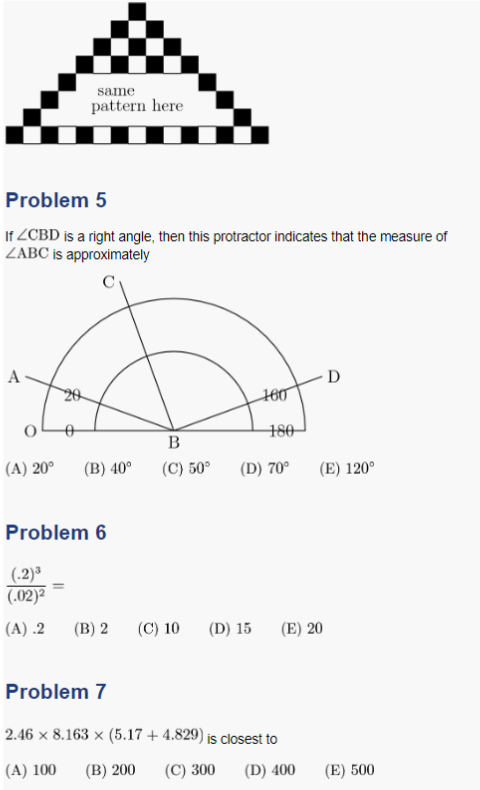
![[asy] draw((0,9)--(6,9)--(6,0)--(2,0)--(2,4)--(0,4)--cycle); label("$A$",(0,9),NW); label("$B$",(6,9),NE); label("$C$",(6,0),SE); label("$D$",(2,0),SW); label("$E$",(2,4),NE); label("$F$",(0,4),SW); label("6",(3,9),N); label("9",(6,4.5),E); label("4",(4,0),S); label("5",(0,6.5),W); [/asy]](https://latex.artofproblemsolving.com/7/f/8/7f82c9ed19cb806bf8dc6f5ba59b67b9714e8ea0.png)
![[asy] unitsize(13); draw((0,0)--(20,0)); draw((0,0)--(0,15)); draw((0,3)--(-1,3)); draw((0,6)--(-1,6)); draw((0,9)--(-1,9)); draw((0,12)--(-1,12)); draw((0,15)--(-1,15)); fill((2,0)--(2,15)--(3,15)--(3,0)--cycle,black); fill((4,0)--(4,12)--(5,12)--(5,0)--cycle,black); fill((6,0)--(6,9)--(7,9)--(7,0)--cycle,black); fill((8,0)--(8,9)--(9,9)--(9,0)--cycle,black); fill((10,0)--(10,15)--(11,15)--(11,0)--cycle,black); label("A",(2.5,-.5),S); label("B",(4.5,-.5),S); label("C",(6.5,-.5),S); label("D",(8.5,-.5),S); label("F",(10.5,-.5),S); label("Grade",(15,-.5),S); label("$1$",(-1,3),W); label("$2$",(-1,6),W); label("$3$",(-1,9),W); label("$4$",(-1,12),W); label("$5$",(-1,15),W); [/asy]](https://latex.artofproblemsolving.com/b/e/7/be7cfa12c227395d9742e20407567d808601a3b2.png)
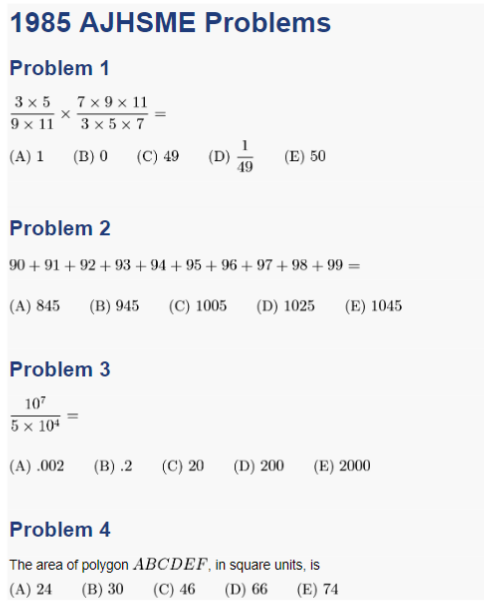
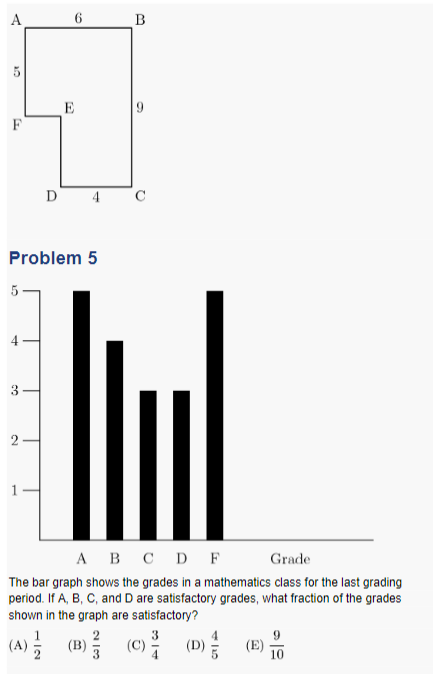
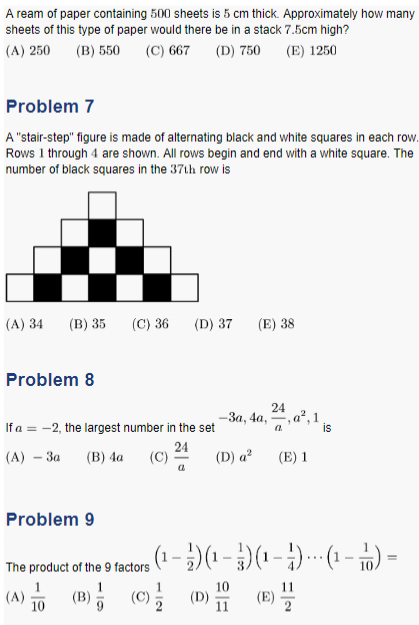
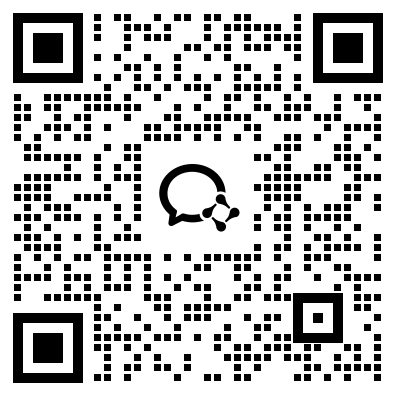
![[asy] draw((0,0)--(4,0)--(4,2.2)--(0,2.2)--cycle,linewidth(.5 mm)); label(".22 m",(4,1.1),E); label(".4 m",(2,0),S); [/asy]](https://latex.artofproblemsolving.com/8/c/c/8cc290473bf98b3c78b84fe4028b8f76279b0e54.png)
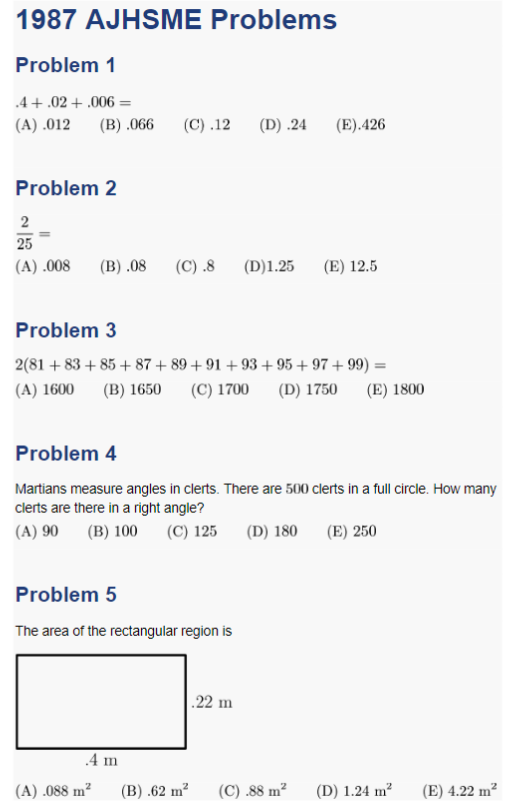
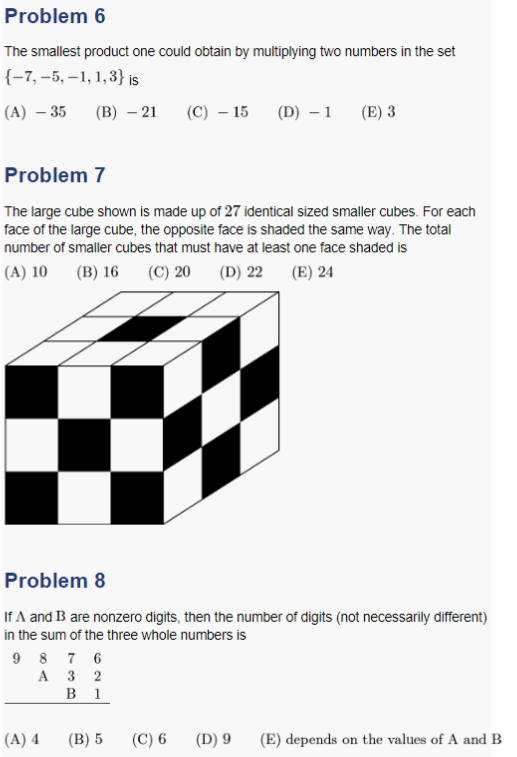
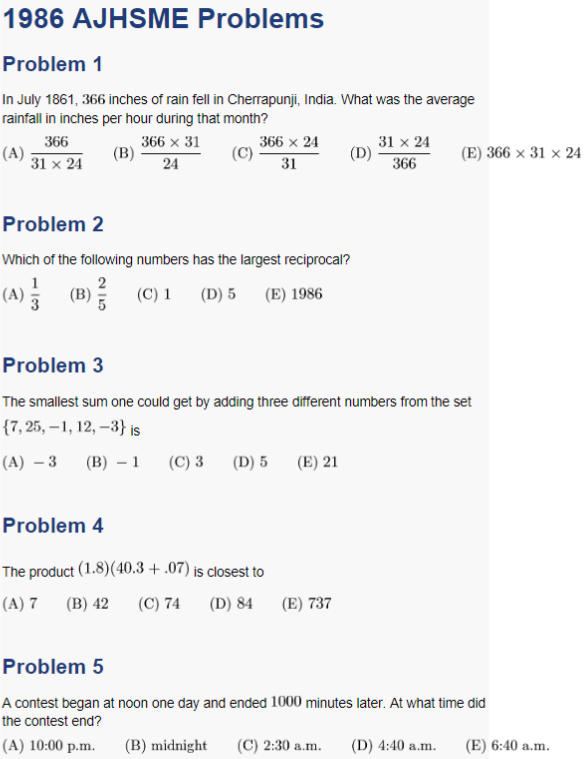
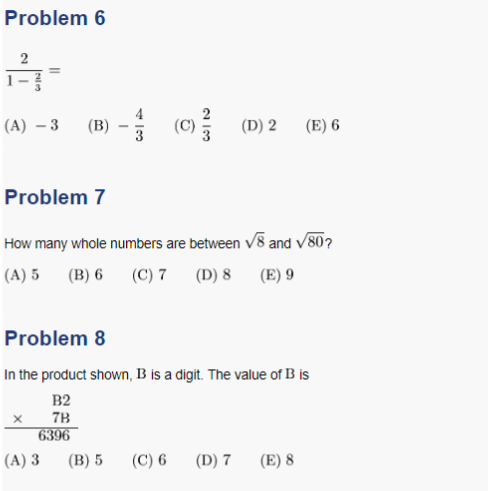
![[asy] unitsize(12); draw((0,0)--(10,0)); draw((-1.5,1.5)--(-1.5,2.5)); draw((-1,2)--(-2,2)); draw((1,1)--(3,1)--(3,3)--(1,3)--cycle); draw((1,4)--(3,4)--(3,6)--(1,6)--cycle); draw((4,1)--(6,1)--(6,3)--(4,3)--cycle); draw((4,4)--(6,4)--(6,6)--(4,6)--cycle); draw((7,1)--(9,1)--(9,3)--(7,3)--cycle); draw((7,4)--(9,4)--(9,6)--(7,6)--cycle); [/asy]](https://latex.artofproblemsolving.com/9/1/4/914e5e0471d3dc0feff40587010f980154414e03.png)
![[asy] draw((0,0)--(0,3)--(3,3)--(3,0)--cycle); draw((0,2)--(2,2)--(2,0)); draw((0,1)--(1,1)--(1,0)); draw((0,0)--(3,3)); fill((0,0)--(0,1)--(1,1)--cycle,grey); fill((1,0)--(1,1)--(2,2)--(2,0)--cycle,grey); fill((0,2)--(2,2)--(3,3)--(0,3)--cycle,grey); [/asy]](https://latex.artofproblemsolving.com/9/4/1/9418063c2f79f6fd1e9f8ec5e2efe31f98590f2f.png)
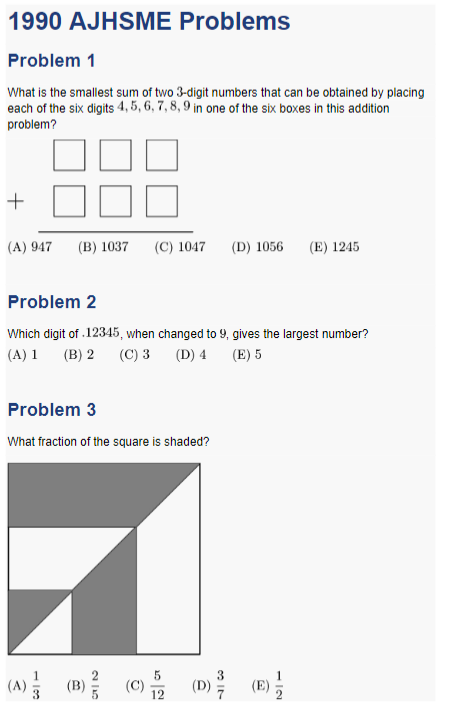
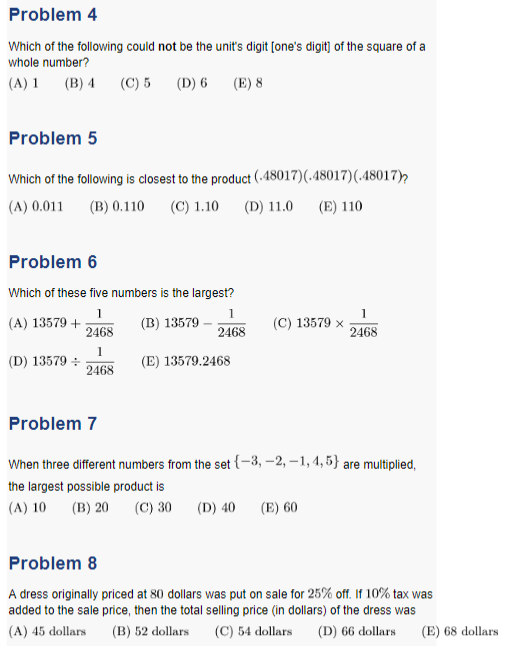
![[asy] unitsize(12); fill((0,0)--(1,0)--(1,1)--(0,1)--cycle,black); fill((1,1)--(1,2)--(2,2)--(2,1)--cycle,black); fill((2,0)--(3,0)--(3,1)--(2,1)--cycle,black); fill((3,1)--(4,1)--(4,2)--(3,2)--cycle,black); fill((0,2)--(1,2)--(1,3)--(0,3)--cycle,black); fill((2,2)--(2,3)--(3,3)--(3,2)--cycle,black); draw((0,0)--(0,3)--(4,3)--(4,0)--cycle); draw((6,0)--(11,0)--(11,3)--(6,3)--cycle); fill((6,0)--(7,0)--(7,1)--(6,1)--cycle,black); fill((8,0)--(9,0)--(9,1)--(8,1)--cycle,black); fill((10,0)--(11,0)--(11,1)--(10,1)--cycle,black); fill((7,1)--(7,2)--(8,2)--(8,1)--cycle,black); fill((9,1)--(9,2)--(10,2)--(10,1)--cycle,black); fill((6,2)--(6,3)--(7,3)--(7,2)--cycle,black); fill((8,2)--(8,3)--(9,3)--(9,2)--cycle,black); fill((10,2)--(10,3)--(11,3)--(11,2)--cycle,black); draw((13,-1)--(13,3)--(17,3)--(17,-1)--cycle); fill((13,3)--(14,3)--(14,2)--(13,2)--cycle,black); fill((15,3)--(16,3)--(16,2)--(15,2)--cycle,black); fill((14,2)--(15,2)--(15,1)--(14,1)--cycle,black); fill((16,2)--(17,2)--(17,1)--(16,1)--cycle,black); fill((13,1)--(14,1)--(14,0)--(13,0)--cycle,black); fill((15,1)--(16,1)--(16,0)--(15,0)--cycle,black); fill((14,0)--(15,0)--(15,-1)--(14,-1)--cycle,black); fill((16,0)--(17,0)--(17,-1)--(16,-1)--cycle,black); draw((19,3)--(24,3)--(24,-1)--(19,-1)--cycle,black); fill((19,3)--(20,3)--(20,2)--(19,2)--cycle,black); fill((21,3)--(22,3)--(22,2)--(21,2)--cycle,black); fill((23,3)--(24,3)--(24,2)--(23,2)--cycle,black); fill((20,2)--(21,2)--(21,1)--(20,1)--cycle,black); fill((22,2)--(23,2)--(23,1)--(22,1)--cycle,black); fill((19,1)--(20,1)--(20,0)--(19,0)--cycle,black); fill((21,1)--(22,1)--(22,0)--(21,0)--cycle,black); fill((23,1)--(24,1)--(24,0)--(23,0)--cycle,black); fill((20,0)--(21,0)--(21,-1)--(20,-1)--cycle,black); fill((22,0)--(23,0)--(23,-1)--(22,-1)--cycle,black); draw((26,3)--(29,3)--(29,-3)--(26,-3)--cycle); fill((26,3)--(27,3)--(27,2)--(26,2)--cycle,black); fill((28,3)--(29,3)--(29,2)--(28,2)--cycle,black); fill((27,2)--(28,2)--(28,1)--(27,1)--cycle,black); fill((26,1)--(27,1)--(27,0)--(26,0)--cycle,black); fill((28,1)--(29,1)--(29,0)--(28,0)--cycle,black); fill((27,0)--(28,0)--(28,-1)--(27,-1)--cycle,black); fill((26,-1)--(27,-1)--(27,-2)--(26,-2)--cycle,black); fill((28,-1)--(29,-1)--(29,-2)--(28,-2)--cycle,black); fill((27,-2)--(28,-2)--(28,-3)--(27,-3)--cycle,black); [/asy]](https://latex.artofproblemsolving.com/0/5/4/0549d7186304b7b16f055941bb248dff3bcbcd70.png)
![\[\begin{tabular}[t]{ccccc} 10 & 6 & 4 & 3 & 2 \\ 11 & 7 & 14 & 10 & 8 \\ 8 & 3 & 4 & 5 & 9 \\ 13 & 4 & 15 & 12 & 1 \\ 8 & 2 & 5 & 9 & 3 \end{tabular}\]](https://latex.artofproblemsolving.com/a/2/f/a2f94b73e928c49ee0bf3205e524e03cf1f6cfb4.png)
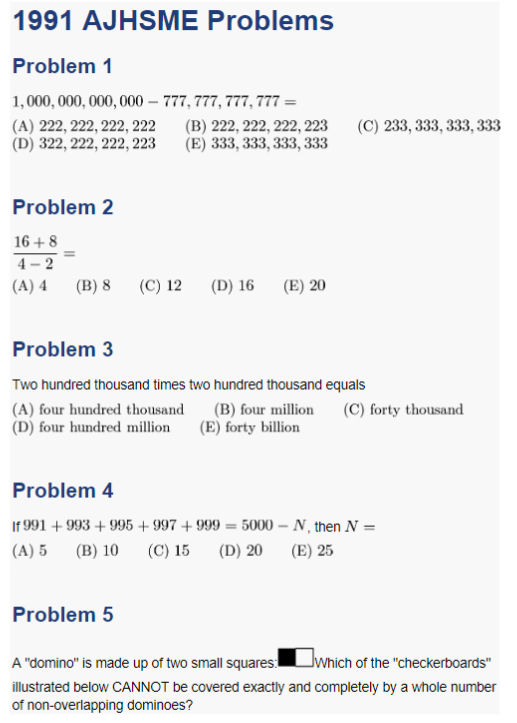
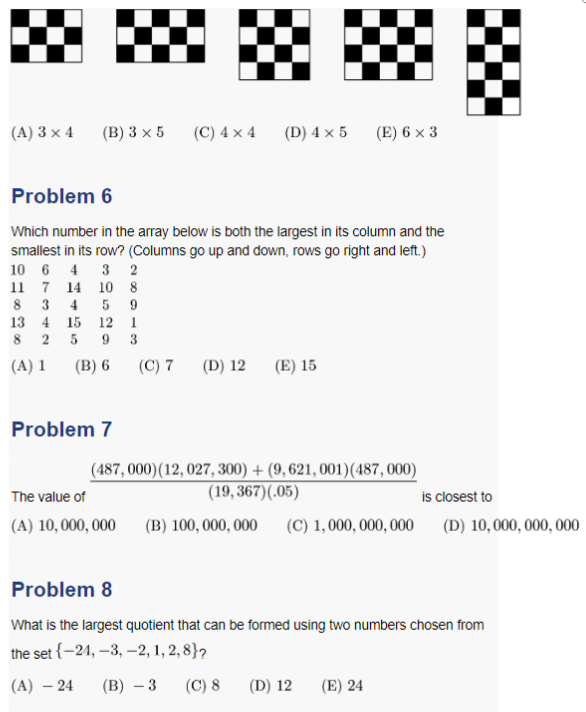
![[asy] fill((0,0)--(0,2)--(3,2)--(3,0)--cycle,gray); draw((0,0)--(0,2)--(3,2)--(3,0)--cycle,linewidth(1)); fill(circle((1,5/4),1/2),white); draw(circle((1,5/4),1/2),linewidth(1)); [/asy]](https://latex.artofproblemsolving.com/1/c/8/1c8b52d197731b410838a3439b6b219ae443fe19.png)
![[asy] unitsize(18); draw((0,0)--(2,0)--(1,sqrt(3))--cycle); label("$a$",(1,sqrt(3)-0.2),S); label("$b$",(sqrt(3)/10,0.1),ENE); label("$c$",(2-sqrt(3)/10,0.1),WNW); [/asy]](https://latex.artofproblemsolving.com/3/6/d/36dbd276ddba01c938b762addfb0e4d14c555db2.png) means
means ![[asy] unitsize(18); draw((0,0)--(2,0)--(1,sqrt(3))--cycle); label("$5$",(1,sqrt(3)-0.2),S); label("$4$",(sqrt(3)/10,0.1),ENE); label("$6$",(2-sqrt(3)/10,0.1),WNW); [/asy]](https://latex.artofproblemsolving.com/8/7/f/87fa64329d26c5fc3e7fbfb572d479dbef63ae93.png) is
is ![[asy] unitsize(18); draw((0,0)--(2,0)--(1,sqrt(3))--cycle); label("$1$",(1,sqrt(3)-0.2),S); label("$3$",(sqrt(3)/10,0.1),ENE); label("$4$",(2-sqrt(3)/10,0.1),WNW); draw((3,0)--(5,0)--(4,sqrt(3))--cycle); label("$2$",(4,sqrt(3)-0.2),S); label("$5$",(3+sqrt(3)/10,0.1),ENE); label("$6$",(5-sqrt(3)/10,0.1),WNW); label("$+$",(2.5,-0.1),N); [/asy]](https://latex.artofproblemsolving.com/6/a/c/6ace4445c995cc99d66def7ca3e0d5cefe90b775.png) is
is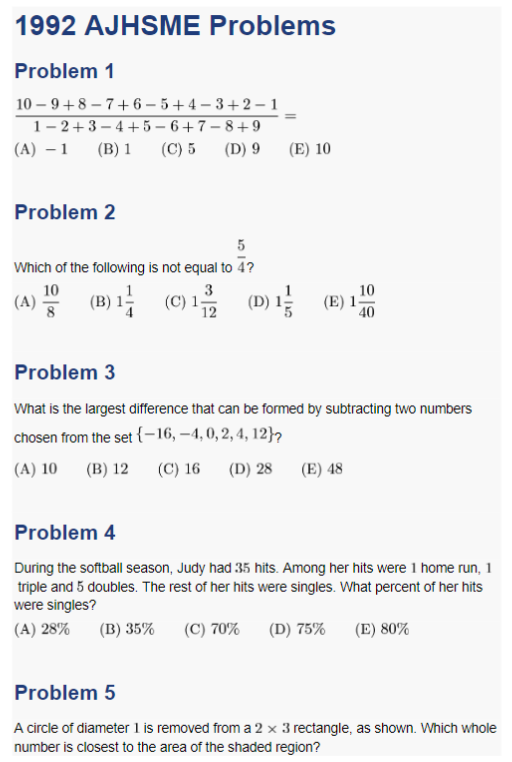
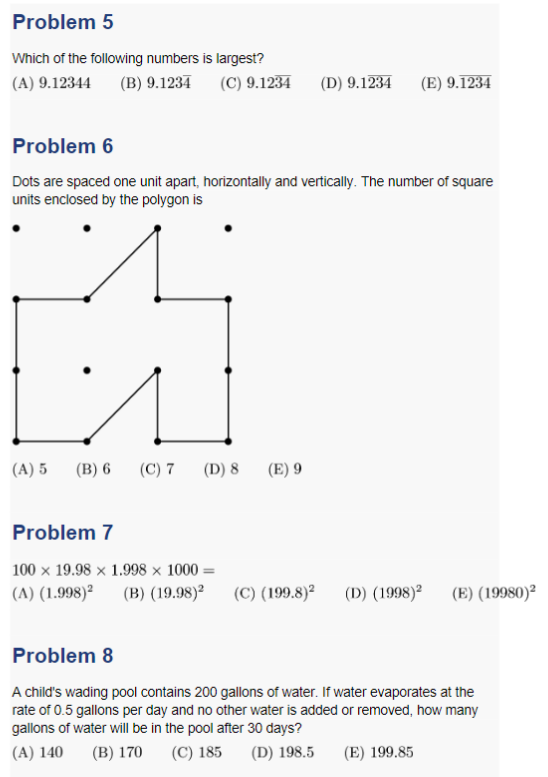
![[asy] unitsize(36); draw(circle((0,0),1),gray); fill((0,0)--arc((0,0),(0,-1),(1,0))--cycle,gray); fill((0,0)--arc((0,0),(1,0),(0,1))--cycle,black); [/asy]](https://latex.artofproblemsolving.com/b/4/8/b480e466979a91180c302aa9c41642901ab83158.png)
![[asy] unitsize(4); fill((1,0)--(1,15)--(5,15)--(5,0)--cycle,gray); fill((6,0)--(6,15)--(10,15)--(10,0)--cycle,black); draw((11,0)--(11,20)--(15,20)--(15,0)); fill((26,0)--(26,15)--(30,15)--(30,0)--cycle,gray); fill((31,0)--(31,15)--(35,15)--(35,0)--cycle,black); draw((36,0)--(36,15)--(40,15)--(40,0)); fill((51,0)--(51,10)--(55,10)--(55,0)--cycle,gray); fill((56,0)--(56,10)--(60,10)--(60,0)--cycle,black); draw((61,0)--(61,20)--(65,20)--(65,0)); fill((76,0)--(76,10)--(80,10)--(80,0)--cycle,gray); fill((81,0)--(81,15)--(85,15)--(85,0)--cycle,black); draw((86,0)--(86,20)--(90,20)--(90,0)); fill((101,0)--(101,15)--(105,15)--(105,0)--cycle,gray); fill((106,0)--(106,10)--(110,10)--(110,0)--cycle,black); draw((111,0)--(111,20)--(115,20)--(115,0)); for(int a = 0; a < 5; ++a) { draw((25*a,21)--(25*a,0)--(25*a+16,0)); } label("(A)",(8,21),N); label("(B)",(33,21),N); label("(C)",(58,21),N); label("(D)",(83,21),N); label("(E)",(108,21),N); [/asy]](https://latex.artofproblemsolving.com/6/a/6/6a6150208e92b19052587795c996686bcd1a5a50.png)
